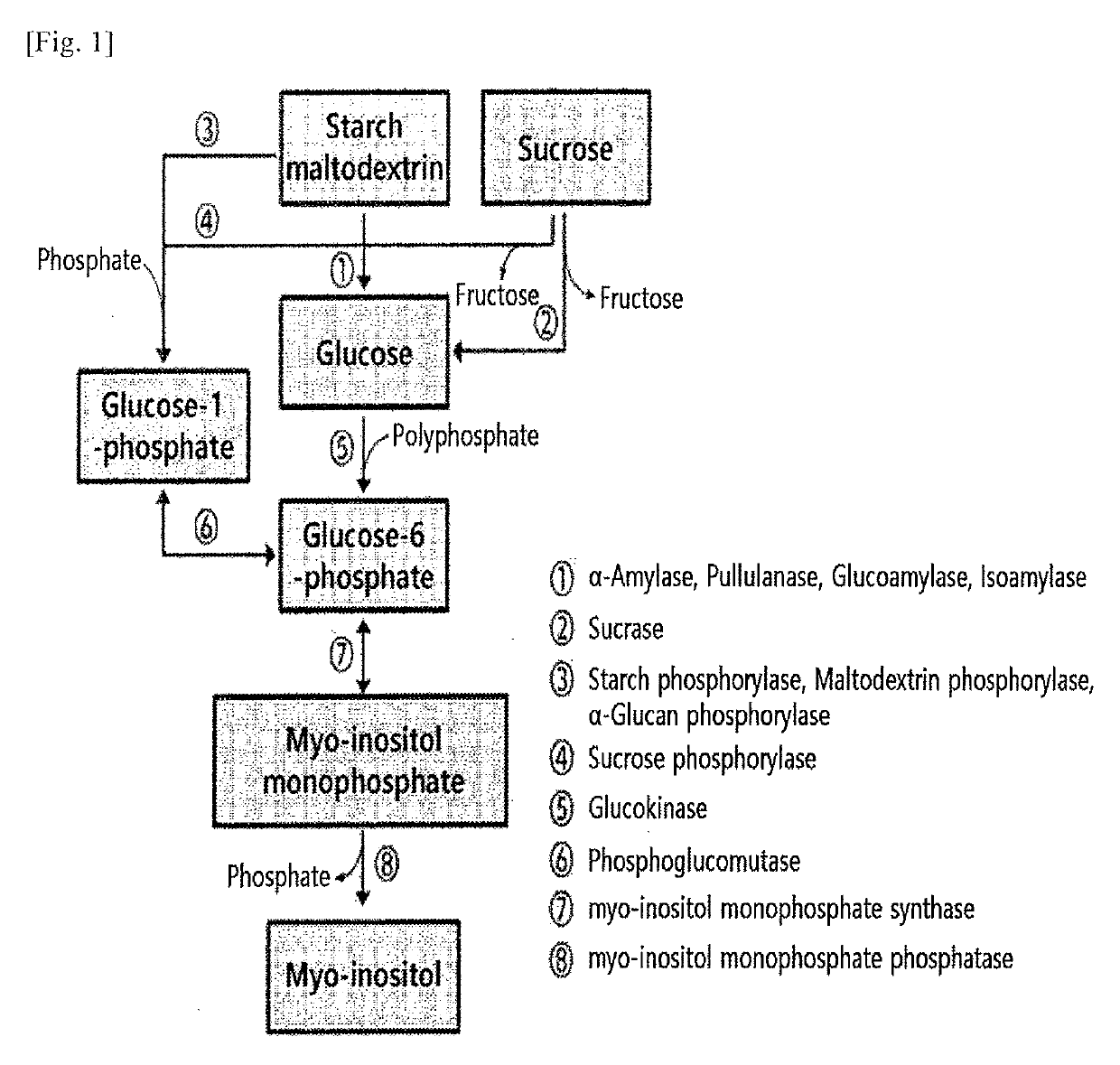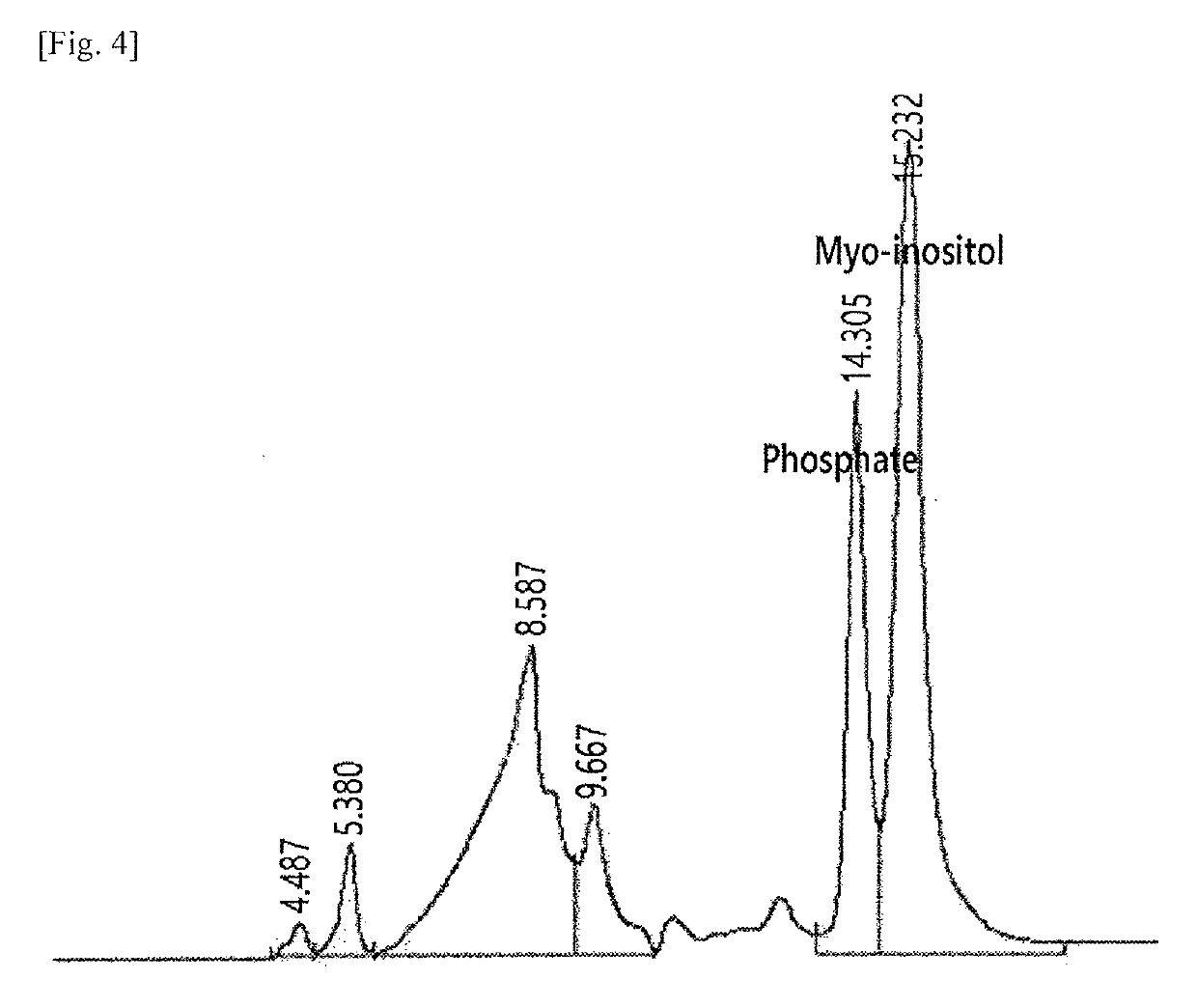Method for enzymatically preparing highly concentrated myo-inositol
- Summary
- Abstract
- Description
- Claims
- Application Information
AI Technical Summary
Benefits of technology
Problems solved by technology
Method used
Image
Examples
example 1
on of Recombinant Expression Vector Containing Genes of Myo-Inositol Monophosphate Synthase and Myo-Inositol Monophosphate Phosphatase, and Transformed Microorganism
[0047]In order to provide heat-resistant myo-inositol monophosphate synthase and myo-inositol monophosphate phosphatase, which are applied to the present disclosure, each gene was separated from the thermophilic microorganism Themotoga neapolitana, and then each of a recombinant expression vector and a transformed microorganism were prepared.
[0048]Specifically, gene sequences related to the enzymes of the present disclosure were selected based on gene sequences of Themotoga neapolitana registered in Genbank. Based on the information of the amino acid sequences (SEQ ID NO: 1, myo-inositol monophosphate synthase; and SEQ ID NO: 3, myo-inositol monophosphate phosphatase) and the nucleotide sequences (SEQ ID NO: 2, myo-inositol monophosphate synthase; and SEQ ID NO: 4, myo-inositol monophosphate phosphatase), forward primers...
example 2
on of Recombinant Enzymes
[0050]In order to prepare recombinant enzymes (hereinafter referred to as ISYN and T6PP), E. coli BL21(DE3) / CJ_tn_isyn and E. coli BL21(DE3) / CJ_tn_t6pp were each inoculated into culture tubes containing 5 mL of LB liquid medium, and then seed culture was initiated in a shaking incubator at 37° C. until the absorbance at 600 nm reached 2.0. The seed culture solution was inoculated into a culture flask containing the LB liquid medium, and the main culture was carried out. When the absorbance at 600 nm reached 2.0, 1 mM IPTG was added to induce expression of the recombinant enzymes. The stirring rate during the culturing process was set to 200 rpm and the incubation temperature was maintained at 37° C. After centrifuging the culture solution at 4° C. at 8,000×g for 20 minutes, cells were recovered. The recovered cells were washed twice with a 50 mM Tris-HCl buffer (pH 7.0), suspended in the same buffer, and then the cells were disrupted using an ultrasonic cell...
example 3
of Recombinant Enzyme Activities
[0052]Glucose-6-phosphate (50 mM) suspended in a 50 mM Tris-HCl buffer (pH 7.5) was used as the reaction composition for analyzing the activity of the myo-inositol monophosphate synthase of the present disclosure. After reacting the reaction composition with a purified enzyme (0.1 unit / mL) and glucose-6-phosphate, i.e., a substrate, at 60° C. for 1 hour, alkaline phosphatase (10 unit / mL) (NEB Inc., Calf Intestinal) was added to each reaction solution and treated at 37° C. for 1 hour, and then the reaction product was analyzed by HPLC. The HPLC analysis was carried out using an SP850 column (Shodex Inc.) while flowing the reaction product to a mobile phase at a flow rate of 0.6 mL / min at 80° C. Thereafter, glucose and myo-inositol were detected and analyzed by a Refractive Index Detector. FIG. 3 shows that the produced recombinant myo-inositol monophosphate synthase has the activity of converting glucose-6-phosphate to myo-inositol monophosphate (FIG. ...
PUM
| Property | Measurement | Unit |
|---|---|---|
| Temperature | aaaaa | aaaaa |
| Temperature | aaaaa | aaaaa |
| Time | aaaaa | aaaaa |
Abstract
Description
Claims
Application Information
 Login to View More
Login to View More - R&D
- Intellectual Property
- Life Sciences
- Materials
- Tech Scout
- Unparalleled Data Quality
- Higher Quality Content
- 60% Fewer Hallucinations
Browse by: Latest US Patents, China's latest patents, Technical Efficacy Thesaurus, Application Domain, Technology Topic, Popular Technical Reports.
© 2025 PatSnap. All rights reserved.Legal|Privacy policy|Modern Slavery Act Transparency Statement|Sitemap|About US| Contact US: help@patsnap.com



